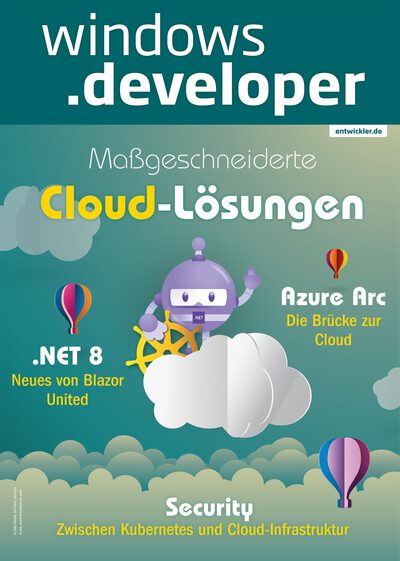This fall, I’m delving into a comprehensive four-part series exploring hybrid cloud solutions through Kubernetes and Azure Arc. The inaugural article, titled “Azure Arc - The Gateway to the Cloud” (Azure Arc - Die Brücke zur Cloud), has been recently featured in the renowned German windows .developer magazine, even making its front page.
The article is available online, but please note that it is in German and requires a subscription to access.
Below, you’ll find the article’s introduction in English and German:
Microsoft offers both software and hardware solutions to assist companies in operating a hybrid cloud. This makes it relatively easy to create a hybrid cloud infrastructure, allowing the benefits of the on-premises and cloud worlds to be combined.
Cloud computing is now ubiquitous, but there are still many companies that do not want or cannot adopt cloud solutions. The most common reasons for this include existing hardware in their own data centers, regulatory requirements, and data management. Especially when dealing with their own or customer data, there are often issues and uncertainties. Many companies do not want to store data in an external data center due to strict data protection regulations or need it in their own data center to provide access with minimal latency.
Microsoft bietet sowohl Software- als auch Hardwarelösungen, um Unternehmen beim Betrieb einer Hybrid-Cloud zu unterstützen. Dadurch kann vergleichsweise einfach eine Hybrid-Cloud-Infrastruktur erstellt werden, wodurch die Vorteile aus der On-Premises- und der Cloud-Welt verbunden werden können.
Mittlerweile ist die Cloud allgegenwertig, allerdings gibt es noch immer eine Vielzahl an Unternehmen, die nicht auf Cloud-Lösungen setzen wollen oder können. Die häufigsten Gründe dafür sind bestehende Hardware im eigenen Rechenzentrum, regulatorische Bedingungen und die Verwaltung von Daten. Vor allem beim Umgang mit den eigenen oder Kundendaten gibt es oft Probleme und Unsicherheiten. So wollen viele Unternehmen die Daten aufgrund der strengen Datenschutzbestimmungen nicht in einem externen Rechenzentrum speichern oder benötigen sie im eigenen Rechenzentrum, um einen Zugriff mit möglichst geringer Latenz zu ermöglichen.



Comments powered by Disqus.